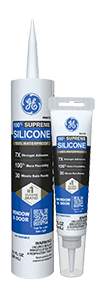When left unsealed, the gaps between your door frame or trim and your home’s siding can let in water, drafts and pests, so it’s important to know how to seal a door frame properly. If you notice your old door sealant is cracked, degrading or damaged, then it’s time to replace it. A new, 100% silicone seal will help keep your home weatherproof, pest-resistant and potentially more energy-efficient.
Tools & Supplies for Sealing Doors
Picking the right sealant for your project can make all the difference. For sealing around the exterior of a door, or anywhere that could be exposed to water and harsh weather, choose a GE-branded 100% silicone sealant, like GE Supreme Silicone Window & Door sealant. This sealant is 100% weatherproof, permanently flexible and won’t crack or shrink with temperature changes. It also offers lifetime mold-free product protection1 so your door sealant will be protected against mold and mildew too.
Pro Tip: 100% silicone sealants are not paintable so be sure to pick a color that matches your home’s exterior. GE Supreme Silicone Window & Door sealant is available in six different colors: almond, black, brown, clear, light gray and white.
Besides a GE-branded 100% silicone sealant, you will also need:
- Caulk gun
- Painter’s tape
- Latex gloves
- Soapy water
- Paper towels
- Stiff bristle brush
- Utility blade
- Caulk tool
- Mineral spirits
- Isopropyl alcohol
Once you have your tools and GE-branded 100% silicone sealant, you’re ready to learn how to seal a door frame to keep out weather, drafts and pests:
-
Start with a Clean Surface
Whenever you start a new sealing project, make sure you have a clean work surface by wiping it down with isopropyl alcohol. If you’re replacing a seal, completely remove the old caulk or sealant, then wipe down the area with isopropyl alcohol. Let the surface dry before laying a new bead.
Safety Tip: Make sure your work area is well ventilated when using isopropyl alcohol.
Applying painter’s tape on either side of the area you’re sealing can help create a smoother bead and easier cleanup. However, depending on your home’s siding and how wide the gaps between it and the door are, it may be better to rely solely on your own steady hand.
-
Carefully Cut the Sealant Cartridge
Next, prepare your sealant by cutting the tip of the cartridge. Cut the cartridge tip at a 45-degree angle. Some caulk guns have a tool to cut the cartridge tip, but we recommend using a utility blade for consistently clean results. Cut off less than you think you’ll need because you can always cut more. Once cut, pierce the cartridge’s inner foil seal using the metal rod on your caulk gun or a long nail. Then load the cartridge into the caulk gun.
-
Apply Sealant
Now apply the sealant. Maintain a relaxed, confident grip and steady speed as you apply the sealant. Run a bead between the door frame and the home’s siding, starting from the top corner and working down to the bottom corner. If you can’t make it in one pass, it’s ok to readjust your grip and start where you left off.
Repeat along the opposite side, and fill gaps with additional sealant as needed.
Seal around everywhere there are gaps between the frame or casing of the door and the rest of the house, including the door sill.
-
Tool the Bead
Use a caulk tool or your finger to tool the sealant bead until it’s smooth. Because it’s important to tool the bead before the sealant starts to cure, it may be better to work in sections. Run a bead of sealant along one side of the door frame, tool the bead, then continue applying sealant on the next side.
-
Remove Painter’s Tape & Let Sealant Cure Completely
If you used painter’s tape, immediately remove it before the sealant has a chance to cure. Remove any excess or unwanted sealant with mineral spirits.
Finally, allow the sealant to cure completely for the best performance. GE Supreme Silicone Window & Door sealant is water-ready in 30-minutes2 and fully cured in 24-hours, but check your product for specific curing instructions.
Now your exterior door has a 100% weatherproof seal that’s made to last. For more step-by-step sealing tutorials with high-performing GE-branded sealants, check out our other How-To guides.
1Cured sealant is resistant to stain causing mold and mildew. Regular cleaning of the cured sealant is required, however, as soap and other residue can cause secondary mold and mildew growth.
2Exposure to water possible in as little as 30 minutes with bead size max 3/16””, temperature min 65oF and humidity min 50%. Otherwise, sealant should not be exposed to water for 8 hours. Do not touch or clean sealant for 24 hours.

